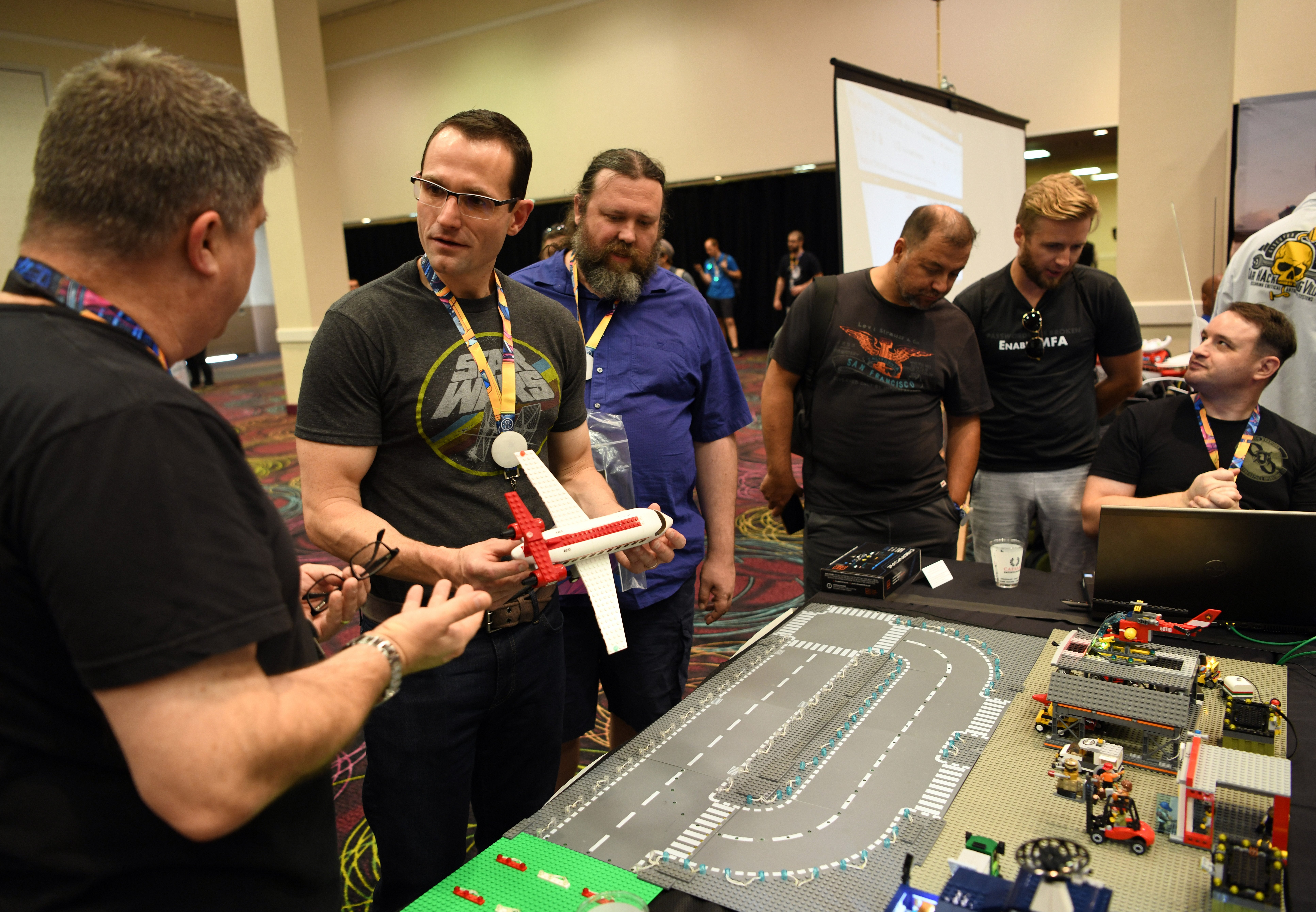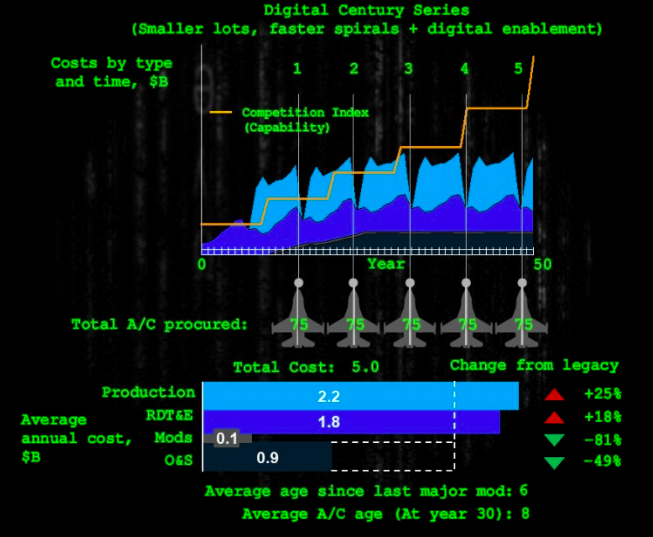
Will Roper, second left
WASHINGTON: Air Force acquisition czar Will Roper revealed today that the service has built a full-scale prototype now in flight testing under the highly classified Next-Generation Air Dominance (NGAD) program — raising myriad questions about future force structure and potential impacts on the five-year budget plan beginning in 2022.
News of the aircraft caught reporters and experts by surprise. “This certainly helps explain where the NGAD funding was going,” Todd Harrison, director of the Aerospace Security Project at the Center for Strategic and International Studies (CSIS), said in an email. “One of the things we noted in our recent budget analysis is that the program was already at a burn rate of around $1B per year, even though the acquisition strategy had not been finalized.”
Roper would not be drawn about details of the new plane’s flight tests, the platform or specific goals for development in a roundtable with reporters following his announcement at the annual Air Force Association conference.
“All I can say is that the NGAD test flights have been amazing — records have been broken,” he said. “But I’ve been impressed by how well the digital technology truly transitions to the real world.”
He added: “A lot of the mission systems that we require for Next-Generation Air Dominance have been flown on test articles, so they are coming along very well, and digital engineering seems to accelerate everything.”
Roper admitted that many issues raised by the new aircraft remain undecided by service leaders, including funding decisions as the service tries to balance current capabilities against future desires and juggle the makeup of its fighter fleet.
“When, where and how we field is a choice with a lot of details,” he said, noting that “it’s a money issue” as well as a question of how NGAD (which is being designed around the idea of a family of manned and unmanned aircraft operating in teams) will “fit in to the tac-air portfolio. It’ll be interesting to see how 2022 plays out.”
Harrison said the service must prove to Congress it needs a more advanced aircraft. “Despite the existence of a prototype, the Air Force is still going to need to make the case that it is time to switch to a new fighter when the F-35A has still not reached full rate production,” he stressed. “The key questions the Air Force will need to answer for Congress are what capabilities does this fighter have that aren’t resident in the F-22 and F-35, how many will it need, how much will it cost, and what is it willing to give up to pay for this (i.e. the opportunity cost).”
Roper told the press roundtable that the acquisition strategy for NGAD is finished, but has not been approved by senior Air Force or Pentagon leaders.
New Air Force Chief of Staff Gen. C.Q. Brown told reporters this afternoon in another roundtable with service leaders — including Roper — there are a number of factors in deciding how to proceed with NGAD. One crucial factor would be maturity of the system vice the evolution of the threats. “I’d also be thinking about the environment and the threat that we’re up against, and will that capability deliver what we need at that timeframe?” he said.
Brown said that a key aspect of deciding how to field NGAD would be getting prototypes “into the hands of the warfighter so they can actually wring it out. And once they’re able to use it, we get feedback.” Digital design tools, he said, make that feedback process much faster.
Indeed, a big part of the NGAD strategy is based on digital engineering, Roper elaborated, and the Digital Century Series concept whereby new iterations of aircraft, based largely on updated software for mission systems, are fielded every five to 10 years.
Roper explained that NGAD is one of three big-ticket Air Force acquisition efforts that are counting on digital design, development, engineering and testing to rapidly upgrade capabilities and cut costs. The other two are the Ground Based Strategic Deterrent and the T-7A Red Hawk trainer, the latter of which built two identical prototypes based on digital designs.
“With digital engineering, everything is sooner. So, if you get it right, everything is faster, cheaper,” Roper said. “I guess if you’re a Star Wars fan, digital engineering makes everything ‘quicker, easier and more seductive’ — but it’s certainly not the Dark Side of the Force,” he said with a laugh. “This is the virtuous, Light Side of the Force and we’re using our powers for good, so it definitely is accelerating everything beyond any expectations that we’ve had of programs in the past.”
In a document released today outlining his goals for “digitizing” Air Force acquisition to his own staff, Roper uses the NGAD program as one of the case studies for how this approach can save money over time as well as speed new capabilities to the field. The document, called Take the Red Pill: The New Digital Acquisition Reality, says that of the three, only NGAD “is “positioned to transform its lifecycle through a fully digital acquisition.”
The use of digital tools to build virtual aircraft models, now dubbed e-series systems by the Air Force, allows program officers and industry to “build down risks” and ensure that production models can be easily upgraded as new capabilities come along. The ability to replace software-driven subsystems with improved capabilities, and avoid vendor lock, is critical to the Digital Century Series concept. 
“Unlike the old paradigm, mission systems, vice platforms, now independently drive capability evolution,” the acquisition document says
The document further argues that “applying digital engineering and management would drop the cost of a notional fighter aircraft by 10 percent over a 30-year life cycle acquisition, with savings spread across production, research, development, test and evaluation (RTD&E) and operations and sustainment (O&S).”
The NGAD digital engineering strategy, the document explains, is aimed at “enabling continuous e-design contracts for three vendors across awarded lots; lowering cost and time for production via determinant assembly; derisking government vice industry subsystem selection; and derisking component commonality required for fleet-wide sustainment.”
The document uses a “notional” acquisition plan of inserting new technologies into the design for the fighter every eight years for lot buys of 75 aircraft, while the previous version of the plane would be retired after 15 years. Roper told reporters deciding how often to upgrade and retire old aircraft was the key trade-off question that has yet to be answered — because it affects costs as well as how quickly warfighters benefit from new tech.
“The big trade is how quickly you spiral, the different aircraft lots in the e-series versus when you retire the airplane,” he said.
Loren Thompson, a long time defense consultant, said in a phone conversation said that convincing Congress that the Digital Century Series is the right way to go will be difficult because small batch buys from more than one vendor eliminates the main benefit to lawmakers — jobs in their districts. Thus while Roper’s conviction that spending money upfront on design, rather than sinking more and more money every year into sustainment, may be correct, it may not be politically viable.
“You may be right, but on Capitol Hill, you could be dead right,” he said.
In a ‘world first,’ DARPA project demonstrates AI dogfighting in real jet
“The potential for machine learning in aviation, whether military or civil, is enormous,” said Air Force Col. James Valpiani. “And these fundamental questions of how do we do it, how do we do it safely, how do we train them, are the questions that we are trying to get after.”


























